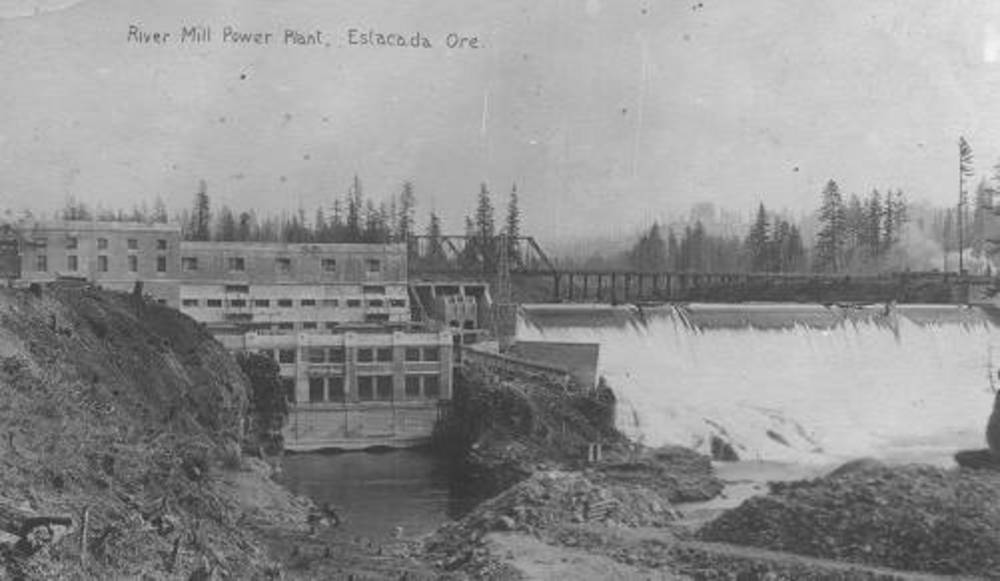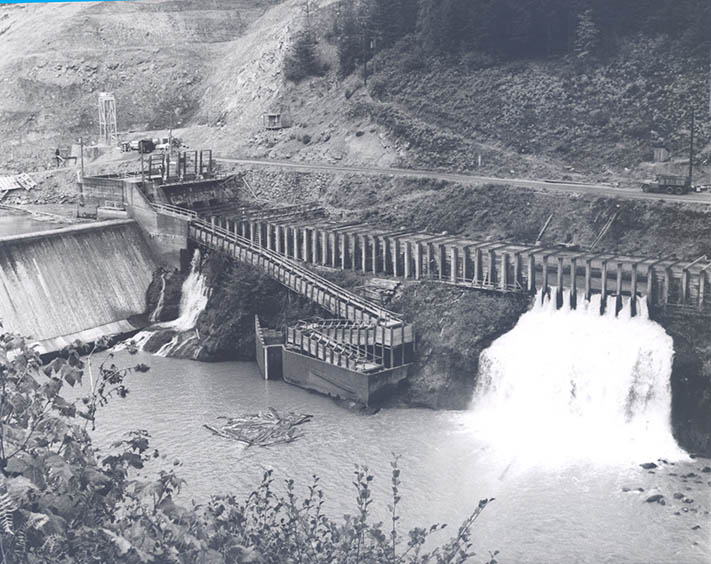The Clackamas River Hydroelectric Project is a series of four powerhouses, dams, reservoirs, and related support and recreational facilities that are owned and operated by Portland General Electric (PGE). Located on 2,365 acres, almost all of it within the Mount Hood National Forest, the project generates 173 megawatts of power.
Interest in the hydroelectric potential of the Clackamas River dates from 1902, when the Oregon Water & Power Company (OWP) began to survey what would become the Faraday Powerhouse to meet the expanding demand for power in the region. The Clackamas River, close to Portland’s population center, was a logical source for new power. It has sufficient capacity but few navigation concerns compared to the area’s other major rivers, the Columbia and the Willamette.
OWP built a rail line to the first dam site, initially called Cazadero and renamed Estacada in 1903. The company built the Estacada Hotel and advertised the area as a tourist destination for fishing and recreation, with the idea of offsetting costs until the powerhouse was operational. The railway allowed OWP and others to log the heavy stands of timber in the project area. Timber was milled locally and then shipped by train to Portland and elsewhere.
The City of Estacada incorporated in 1905, and OWP completed its thirty-two-mile line in 1906, with branch lines to Fairview and Troutdale. The company and all of its assets were merged to create Portland Railway Light & Power (PRLP) in 1906, creating a massive corporation that unified all power and transportation utilities in the region.
PRLP completed the Faraday Powerhouse, which went into operation in February 1907. River Mill, the second power project on the Clackamas, was completed in 1911. Construction of the Oak Grove Powerhouse, upstream on the Oak Grove Fork of the Clackamas, began in 1921; the first unit went on line in 1924, with another added in 1931. The Three Lynx Housing Complex, at Oak Grove, and Lake Harriet, farther upstream on the Oak Grove Fork, were built in 1923-1924 as part of the Oak Grove development.
Construction at Oak Grove, in steep and difficult terrain, nearly bankrupted PRLP, which had to extend the rail line miles into the forest to supply materials. An infusion of new eastern capital and corporate restructuring that split the railroad and power companies into separate entities again put the company on solid footing and ultimately resulted in the creation of Portland General Electric in 1930.
The development of hydroelectric facilities on the Clackamas River opened the area to increased growth and commercial activity, through the multiyear construction phase and as a result of the railroad line and the development of direct train service to Portland and elsewhere. Farmers were able to ship produce and other products on a daily basis, and area logging increased with the availability of the trolley line for shipping. Portland residents took excursion trips to Estacada for recreation, including a Fisherman’s Special that ran on the weekends. The trolley brought new industry and people into the Clackamas River valley. As train passenger service declined in the 1920s, the roadbed of the railroad served as the right of way for what is now Oregon State Highway 224.
Power operations provided an important source of employment in the Clackamas Valley throughout the Depression and the 1940s. The Three Lynx employee community boasted its own school, operated by the Estacada School District.
In 1954, new developments at North Fork and an additional unit at Faraday increased the generation capacity of the Clackamas River and supported increased energy demand throughout northern Oregon. North Fork, the newest and largest of the Clackamas projects, went into operation in 1958. In addition, recreational facilities and campgrounds opened at Promontory Point above North Fork Reservoir, at Lake Harriet, and in Faraday Park, upstream from the River Mill Dam. Four campgrounds at Timothy Lake, a project reservoir completed in 1956, are operated under an agreement with the U.S. Forest Service.
-
![]()
River Mill Dam area, 1910.
Oregon Historical Society Research Library, Org. lot 151, PGE13-4
-
![]()
Cable cart across the Clackamas, Oak Grove project, 1922.
Oregon Historical Society Research Library, Org. lot 151, PGE16-132
-
![]()
Cottages at Three Lynx, 1930.
Oregon Historical Society Research Library, Org. lot 151, PGE16-1046 -
![]()
Construction camp at Oak Grove Fork, Clackamas, 1931.
Oregon Historical Society Research Library, Org. lot 151, PGE16-1013
-
![]()
Mill River power plant.
Oregon Historical Society Research Library, Org. lot 151, PGE11-6010
-
![]()
River Mill Dam, 1910.
Oregon Historical Society Research Library, Org. lot 151, PGE13-21
-
![]()
Oak Grove Project, Clackamas, c.1920.
Oregon Historical Society Research Library, Org. lot 151, PGE16-210
-
![]()
Oak Grove powerhouse and the Three Lynx camp, 1924.
Oregon Historical Society Research Library, Org. lot 151, PGE16-781 -
![]()
Estacada Hotel and train.
Oregon Historical Society Research Library, Org. lot 151, PGE49-45
Related Entries
-
![Estacada]()
Estacada
Estacada (pop. 3,400 in 2018) sits on the right bank of the Clackamas R…
-
![Faraday Dam and Powerhouse]()
Faraday Dam and Powerhouse
The Faraday Powerhouse, located in Estacada on the Clackamas River, pro…
-
![Portland Railway Light and Power]()
Portland Railway Light and Power
Portland Railway Light & Power (PRLP) was created in 1906 through the c…
Related Historical Records
Map This on the Oregon History WayFinder
The Oregon History Wayfinder is an interactive map that identifies significant places, people, and events in Oregon history.
Further Reading
Kramer, George. Clackamas River Hydroelectric Project-Request for Determination of Eligibility. Eugene, Ore.: Heritage Research Associates, Inc., for PGE, June 2003.
Federal Energy Regulatory Commission. Final Environmental Impact Statement, Clackamas River Hydroelectric Project No. 2195-011, December 2006.
Wollner, Craig. Electrifying Eden: Portland General Electric 1889-1965. Portland: Oregon Historical Society Press, 1990.











